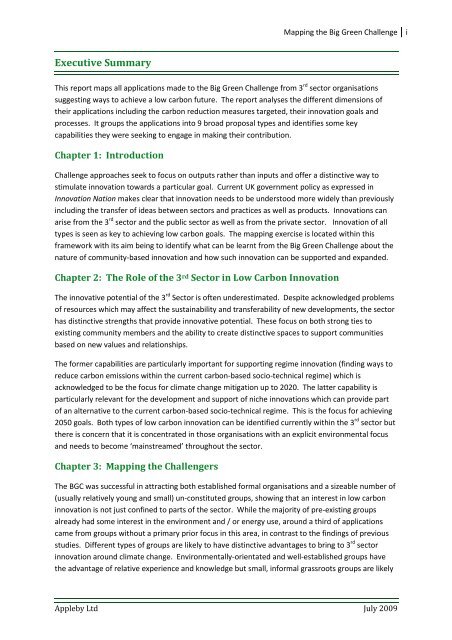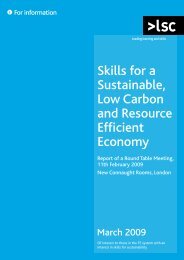Mapping the Big Green Challenge - The Skills & Learning ...
Mapping the Big Green Challenge - The Skills & Learning ...
Mapping the Big Green Challenge - The Skills & Learning ...
You also want an ePaper? Increase the reach of your titles
YUMPU automatically turns print PDFs into web optimized ePapers that Google loves.
<strong>Mapping</strong> <strong>the</strong> <strong>Big</strong> <strong>Green</strong> <strong>Challenge</strong>iExecutive SummaryThis report maps all applications made to <strong>the</strong> <strong>Big</strong> <strong>Green</strong> <strong>Challenge</strong> from 3 rd sector organisationssuggesting ways to achieve a low carbon future. <strong>The</strong> report analyses <strong>the</strong> different dimensions of<strong>the</strong>ir applications including <strong>the</strong> carbon reduction measures targeted, <strong>the</strong>ir innovation goals andprocesses. It groups <strong>the</strong> applications into 9 broad proposal types and identifies some keycapabilities <strong>the</strong>y were seeking to engage in making <strong>the</strong>ir contribution.Chapter 1: Introduction<strong>Challenge</strong> approaches seek to focus on outputs ra<strong>the</strong>r than inputs and offer a distinctive way tostimulate innovation towards a particular goal. Current UK government policy as expressed inInnovation Nation makes clear that innovation needs to be understood more widely than previouslyincluding <strong>the</strong> transfer of ideas between sectors and practices as well as products. Innovations canarise from <strong>the</strong> 3 rd sector and <strong>the</strong> public sector as well as from <strong>the</strong> private sector. Innovation of alltypes is seen as key to achieving low carbon goals. <strong>The</strong> mapping exercise is located within thisframework with its aim being to identify what can be learnt from <strong>the</strong> <strong>Big</strong> <strong>Green</strong> <strong>Challenge</strong> about <strong>the</strong>nature of community-based innovation and how such innovation can be supported and expanded.Chapter 2: <strong>The</strong> Role of <strong>the</strong> 3 rd Sector in Low Carbon Innovation<strong>The</strong> innovative potential of <strong>the</strong> 3 rd Sector is often underestimated. Despite acknowledged problemsof resources which may affect <strong>the</strong> sustainability and transferability of new developments, <strong>the</strong> sectorhas distinctive strengths that provide innovative potential. <strong>The</strong>se focus on both strong ties toexisting community members and <strong>the</strong> ability to create distinctive spaces to support communitiesbased on new values and relationships.<strong>The</strong> former capabilities are particularly important for supporting regime innovation (finding ways toreduce carbon emissions within <strong>the</strong> current carbon-based socio-technical regime) which isacknowledged to be <strong>the</strong> focus for climate change mitigation up to 2020. <strong>The</strong> latter capability isparticularly relevant for <strong>the</strong> development and support of niche innovations which can provide partof an alternative to <strong>the</strong> current carbon-based socio-technical regime. This is <strong>the</strong> focus for achieving2050 goals. Both types of low carbon innovation can be identified currently within <strong>the</strong> 3 rd sector but<strong>the</strong>re is concern that it is concentrated in those organisations with an explicit environmental focusand needs to become ‘mainstreamed’ throughout <strong>the</strong> sector.Chapter 3: <strong>Mapping</strong> <strong>the</strong> <strong>Challenge</strong>rs<strong>The</strong> BGC was successful in attracting both established formal organisations and a sizeable number of(usually relatively young and small) un-constituted groups, showing that an interest in low carboninnovation is not just confined to parts of <strong>the</strong> sector. While <strong>the</strong> majority of pre-existing groupsalready had some interest in <strong>the</strong> environment and / or energy use, around a third of applicationscame from groups without a primary prior focus in this area, in contrast to <strong>the</strong> findings of previousstudies. Different types of groups are likely to have distinctive advantages to bring to 3 rd sectorinnovation around climate change. Environmentally-orientated and well-established groups have<strong>the</strong> advantage of relative experience and knowledge but small, informal grassroots groups are likelyAppleby Ltd July 2009











